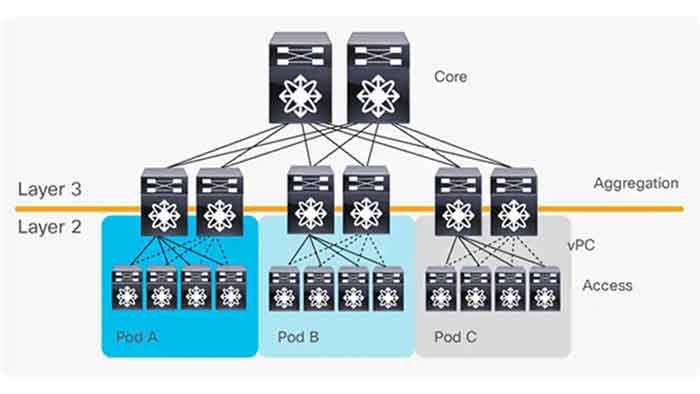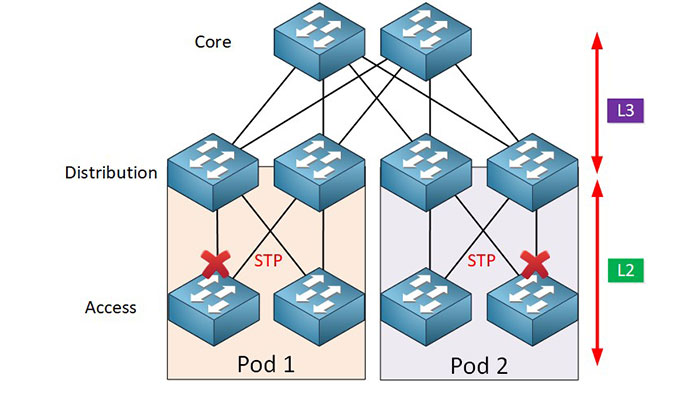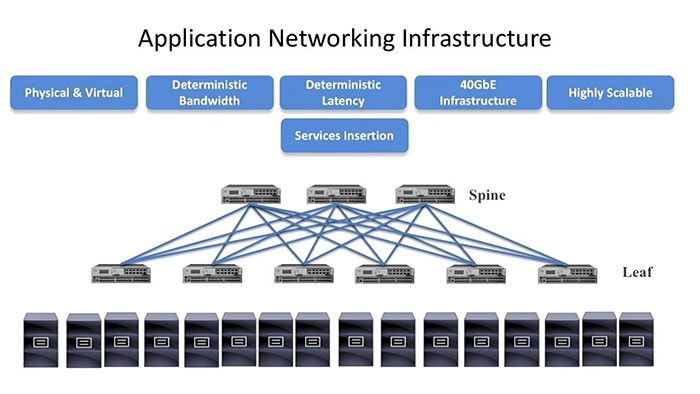
Modern data center traffic is becoming more and more heavy between servers. if you haven’t adopted the new two-tier Ethernet switching architecture called Cisco Spine and Leaf Architecture, you probably will soon.
Network enterprises used to use three-tier hierarchical network model for a long time. Cisco License suggests Three Layer hierarchical network model, that consists of three different layers for design and deployment purposes, The Core layer, the Distribution layer, and the Access layer.

In this architecture, the core Layer includes the biggest, fastest, and most expensive routers with the highest model numbers and is assumed as the back bone of networks. Core Layer routers are used to merge geographically separated networks in order to move information on the network as fast as possible.
The Distribution Layer which is located in the middle of core and access layers, provide boundary definition by implementing access lists and other filters. So the Distribution Layer defines policy for the network using high-end layer 3 switches and ensures that packets are properly routed between subnets and VLANs in your enterprise.
And finally, Access layer includes access switches which are connected to the end devices such as computers, printers and etc. Access layer switches ensures that packets are delivered to the end devices.
The three-layer hierarchical architecture has some advantages and disadvantages. Availability, security, scalability and familiarity are the main pros of this architecture while limited bandwidth and latency are the most known cons for this model. Although, migrating to spine and leaf architecture which is introduced by Cisco to address these challenges providing better infrastructure for enterprises and data center network as part of its Application Centric Infrastructure technology, is highly recommended.

Cisco Spine and Leaf Architecture
In Cisco Spine and Leaf Architecture, every leaf switch is connected to each of the spine switches in a full-mesh topology. The leaf layer includes access switches that connect to devices such as servers while the spine layer is the backbone of the network and is responsible for interconnecting all leaf switches.
The path is randomly chosen so that the traffic load is evenly distributed among the top-tier switches. If one of the top tier switches were to fail, it would only slightly degrade performance throughout the data center. In this method, an additional spine switch can be added, and uplinks can be extended to every leaf switch, resulting in the addition of interlayer bandwidth and reduction of the oversubscription.
With a Cisco Spine and Leaf Architecture, no matter which leaf switch to which a server is connected, its traffic always has to cross the same number of devices to get to another server (unless the other server is located on the same leaf). This way of approach keeps latency at a predictable level because a payload only has to hop to a spine switch and another leaf switch to reach its destination.
The FabricPath spine-and-leaf network provides a simple, flexible, and stable network, with high scalability and fast convergence characteristics. FabricPath IS-IS as its control plane, is designed to determine FabricPath switch ID reachability information. To know end-host reachability information, FabricPath switches rely on initial data-plane traffic flooding.
A Layer 3 function is laid on top of the Layer 2 network. Common Layer 3 designs use centralized routing: that is, the Layer 3 routing function is centralized on specific switches (spine switches or border leaf switches). The FabricPath network supports up to four any-cast gateways for internal VLAN routing.
The Cisco Nexus 9000 family has introduced different models of fixed (Cisco Nexus 9300) and modular (Cisco Nexus 9500) switches such as Cisco Nexus 9332C and Cisco Nexus 9364C to be deployed in the spine-and-leaf network as a spine switch. Cisco Nexus 9000 Series spine switches enable an automated and policy-based Cisco ACI architecture.

All features and capabilities on this switches would be enables by using Cisco Nexus PLR license.
The Cisco Nexus 9000 portfolio also consists of various models to be deployed as a leaf switch in spine-and-leaf architecture. These switches provide low latency with up to 3.6Tbps of bandwidth enables customers to build a robust switch fabric scaling from as few as 200 10-Gbps server ports to more than 200,000 10-Gbps server ports.
Also they can support up to a total of 50 MB of integrated shared buffer space allows better management of speed mismatch between access and uplink ports. Moreover, they provide Hot-swappable, redundant power supplies and fan trays increase availability. All premium features can be enabled by using Cisco Nexus 9000 PLR license on these switches.